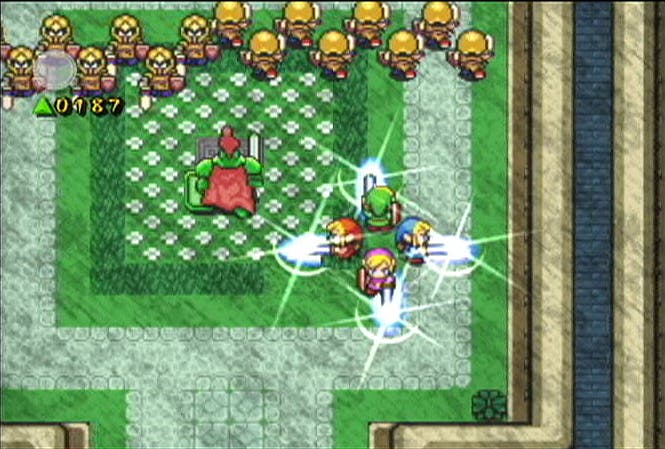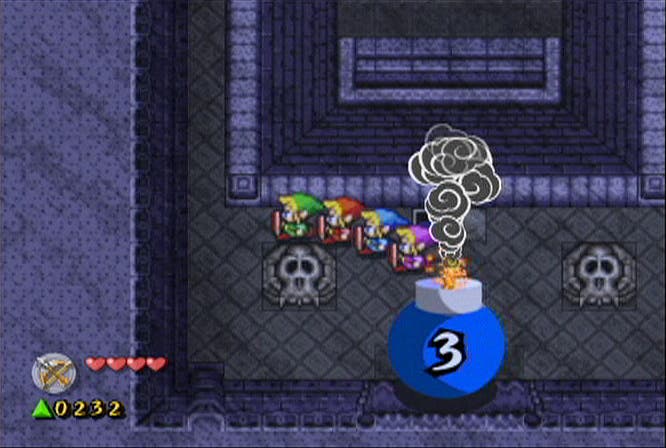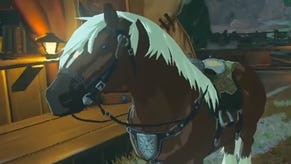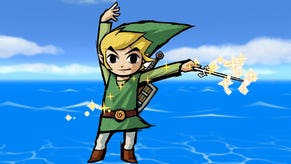The Legend of Zelda: Four Swords Adventures
The best Cube-GBA link game since Pac-Man Vs.

"How did you feel being denied these... Hungry, Hungry Hippos?"
"Well, Dr. Thurman," we would have responded (assuming we'd managed to avoid falling into an onanistic trance), "we didn't actually mind, because we couldn't assemble a four-strong group prepared to play it for six hours in a row, and on a fundamental design level we always seriously objected to being robbed of our little white balls at the end of each round. The world of Hungry Hippos should have been much more persistent."
Except we wouldn't have responded that way. Obviously. Because what Hungry Hippos represented - and still represents on those guiltily juvenile nights in with a bottle of Merlot and similarly fun-loving friends - was short-lived but frantic entertainment, something that fulfilled a social urge that just about everybody has. The Legend of Zelda: Four Swords Adventures is, on some level, a similar beast, and criticising it for not being the multiplayer equivalent of War & Peace is somewhat missing the point. Of course Zelda represents progressive, inspiringly layered quests that grow in complexity and mature into one big, long Crystal Maze-esque gauntlet where every grain of sand in the mock-Incan lateral-thinking temple hub is put to fine use and Richard O'Brien is a boat with the heart of a dragon or a wise old witch living in a tree somewhere waiting to charge you with a quest. But if that's what you're after, you already have Minish Cap to make do with - not to mention all the other Zelda games. Four Swords Adventures doesn't slavishly toe the party line; it toes a line of friends into a party mood. Whether or not that's cause to assault it as some already have is a reflection of your expectations. And the importance of the names in your address book.
Four Swords Adventures is not really a traditional Zelda game. Rather it's a refined interpretation of the formula that has been stripped of some of its clunkier aspects like multi-item inventory systems and streamlined in such a way that a group of players can co-operatively explore and excite themselves tearing it apart. And, yes, that is "refined" rather than "dumbed down"; double-D derision is best kept for something that's been stripped of its soul for the sake of mass-market appeal, whereas the inherent shrewdness of the Four Swords design demonstrates it's quite the opposite. A boss monster that requires you to "pass" a coloured orb like a tennis ball between four differently-coloured characters before batting it back to stun him into a state of vulnerability, and puzzles that involve co-operatively balancing the effects of your actions in two parallel dimensions, aren't exactly Jane Austen directed by Michael Bay. They're not Jane Austen directed by Michael Mann either, but they maintain the series' habit of drip-feeding intoxicatingly euphoric achievement - only here you get to share that sensation with a group of friends. Before complaining bitterly that you just got toasted by somebody's Fire Rod and cursing the AI-controlled Fuscia Link.

The concept is simple. Link has been split into four Links by a mysterious blade known as, get this, "the Four Sword", and naturally finds himself on a sacred quest that involves vanquishing evil and rescuing seven princesses who have been enshrined in crystals at various points around the world by an evil sorcerer. Up to four players plug in using a Game Boy Advance as the controller and direct whichever Link they happen to control in a 16-bit-style top-down Zelda environment, using the D-pad to move, B to slash with a sword, A to use a currently-held item and the right shoulder button to pick up rocks, bushes, pots and the like ("the like" can include your fellow players, masochistically) and chuck them around. The L button is reserved for forming up into a line or other formation in single-player mode, and zooming in on your character in multiplayer so you can find him quickly. And speaking of single-player - it's also possible to play using the regular Cube pad, with any GBA action appearing on a little pop-up GBA screen.
On the surface, then, it's much like a normal Zelda adventure; you journey through a neatly contained world talking to friendly NPCs, killing unfriendly NPCs and working out how to get to every last treasure chest, find every crucial item and explore every nook and cranny. Except in this case, each section of the game is a "level" in an arcade sense, with three levels per world and eight worlds overall. At the end of each level you break a seal to forge on to the next one, your item and gem counts are both zeroed, and the game runs through various statistics to tell you who "won".
What this means in practice is that every level is utterly self-contained, like a little microcosm of a full Zelda game where not only is everything intrinsically linked so that making progress is satisfyingly all-encompassing, but it also means you can actually picture the entire level and everywhere you haven't been in your head at any given time. Which are the same principles that brought us the best bits of all the other Zelda games: the dungeons. In effect, then, it's a game that consists of more than 20 Zelda dungeons of varying quality. Is that not worth celebrating? And, naturally, with four brains thrown into the task of solving puzzles, someone is bound to stumble upon the solution sooner rather than later.
Now, it's worth mentioning at this point that you could argue, as someone ill-advisedly did in the pub the other night, that swifter puzzle consumption is only so much of a boon for the formula given the comparative vastness of play areas in "proper" Zelda games, and the amount of other things they let you go off and do whilst you ponder the brainteaser du jour. But we'd turn around and argue that that's rubbish; dungeons in the others were often perfectly capable of prompting an impasse that scuttled enthusiasm, and in any case how much more satisfying has Zelda always been to play with somebody on your shoulder to try and help think things through? We're not going to rail on Four Swords for using this split-levels approach. Play with it for a while without expecting another Ocarina and you'll realise that you don't just like it; you really like it. It's perfect to dip into for a while. Just like Hungry Hippos.

And whilst we're praising it, we ought to draw attention to some of the other refinements that help four players thrive mostly without unwanted interruption. The heavily-publicised tactic of moving in-cave, in-house and other environments outside the main play area onto the GBA screen works very well indeed. Even the side-scrolling platform-esque sections that recall the agony of Zelda II don't grate, because they're intermittent and don't betray the style or pace. It also means that your party can split up to a certain extent - scampering off to slash bushes for jewels, going into houses to talk to NPCs (dialogue is also generally on the GBA screen) and so on - and this split focus is also possible when you're all on the same screen thanks to the Cube's capacity to zoom out and offer a much wider view of a particular area. Actually, while we're on that note, we'd like to hug and kiss whoever decided to make a game that looks like A Link To The Past but has Wind Waker-style curly explosions and world-bending visual effects, and occasionally uses the relatively low system drain to populate Hyrule with hundreds of everything of which you usually only expect to see one or two. Genius.
Getting back to the split-focus tasks and the sense of being able to shuffle off on your own, however, the key factor is that you're all fundamentally bound to one another by the need to journey to different areas as a group, the need to assemble to operate four-man levers and formation switch puzzles, the way you can only hold one item (boomerang, hammer, Pegasus boots, etc) at a time per character and the need for co-ordination on that level, and by the frequent need to have one player in one place and another in another working together. All this and the "scoring" at the end of each level generally means that the main theme of a multiplayer session is contemplative camaraderie with a competitive edge - delivered with a distinctly comic lilt, typified by the hoots of laughter that accompany any act of buttock-singing or gem-thieving naughtiness, and crystallised by the hilarity of being able to impact a certain player's ranking by voting him the most irritating of the bunch between levels.
It's fun. But it's not nothing but fun. For all its obvious quality, there are some things that let it down. Tingle's mini-games, for example, unlocked as you go through the game, are as short-lived as you grumpily wish the little fairy bastard's influence ever had been in the first place. But more significantly the inconsistent level design, and the amount of elements recycled almost completely from earlier Zelda titles, are disappointing. First, the inconsistencies. It's a mystery to us how this game can serve up something as delicately balanced and logical as the Village of the Blue Maiden - your first introduction to the multi-dimensional Rubik's Cube that is the dark/light world separation - and then immediately use the same techniques to bore you with a rehashed version of a Link To The Past dungeon culminating in a middle of the road boss with a spinny ring of mini-minions to protect him. Fortunately, inspired levels are far more prevalent than anything else, but there are still too many that feel like a chore; one that springs to mind is a Dark Forest level about halfway through, which involves dodging lots of hard or impossible to kill enemies in a network of four-way junctions, punctuated by fetch-quests. It feels more like navigating a Dark Ages version of Milton Keynes on behalf of Domino's Pizza than anything else.

Persevere though - the groupthink approach to puzzling and the ongoing banter about who set fire to whose backside should help - and there are enough moments of magic to see Four Swords through to the end, and it won't be something you finish in a couple of evenings, either. Examples could fill a book - four gamers dodging searchlights and sneaking into Hyrule castle, giggling whenever someone's greed leads him to smash a pot, attract a searchlight and wind up in the clink; shooting arrows through flames to light torches lurking in the darkness; using a boomerang to grab the keys to a cell from inside; using four Links to physically push a room within a room over a hole and use its bombed out north and south entrances to make headway... And thanks to its level-by-level approach, you can always put it down at the end of the night and reassemble a few weeks later without having to sit around for 20 minutes trying to remember what the hell was going on last time. It's pick-up-and-play like that. So much so, in fact, that you can rejoin a saved quest on any level you've already completed or opened up - with any number of players. Even all by your lonesome.
Now, we don't particularly recommend playing Four Swords Adventures by yourself if you can avoid it, because although there is a provision for organising your three AI-controlled (and mercifully fairly indestructible) colleague-Links in appropriate formations, and splitting up where needed, the design is geared towards four people, so even with a procession of four Links to control you'll still have to retrace your steps all the time to complete menial tasks like putting out fires, and the hordes of enemies will require four times as much slashing because there's no way to send your fellow Links off to fend for themselves. But then, on the other hand, it is perfectly playable on your own, and the wealth of fun is enough to overcome the various minor irritations. This reviewer actually completed the majority of the game single-handedly, and was glad to, even though the multiplayer sessions are undoubtedly the best reason to own it.
"Regret." We'd regret not having experienced Four Swords (and Hungry Hippos) if we'd known what we now know about it. It won't satisfy everybody - and we'd stress again the importance of approaching it as a new experience inspired by an old favourite rather than expecting the expected - but those who band together to tackle the evil sorcerer Vaati will likely be spellbound by a tremendously well-designed example of modern multiplayer gaming. It may sound like a step backward to those Zelda fans for whom concepts like "levels" are blasphemy (and we sympathise; we worried about it too), but the result is more like a genuine step forwards for multiplayer gaming, wrought from some of the best single-player game design ever put out to pasture. And, ironically, while Zelda stories have never done much to tug on our heartstrings the way epic Japanese turn-based RPGs have done, Four Swords managed to make us laugh and cry within the space of about three hours. Or rather, the people we were playing it with did; but if you ask us, in the context of whether or not you should buy Four Swords, the social factor is one you'd be foolish to discount.






